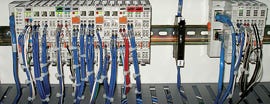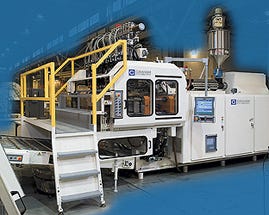New control system improves blow-molding machines
January 30, 2014

Industrial Ethernet I/O technology provides high-speed control of the parison programmers on the blow-molding machines, thus assuring higher-quality bottles.
Graham Engineering Corp. (GEC [www.graham]), York, PA., specializes in high-end blow-molding machinery and equipment for the nonpolyethylene terephthalate segment of the fluid bottling and packaging market. Its machines are widely used at plants that manufacture bottles to be immediately filled with automotive fluids, household detergents and cleansers, and beverages that are marketed in nontransparent bottles. A large number of GEC's customers also make empty bottles for resale in the same automotive, household and beverage industries.
The Graham Wheel product, which was GEC's first major product entry into the blow-molding machine market, has been made for more than 30 years, with installations worldwide. They now represent a dominant technology in the production of high-output blow-molding systems. The main component of the Wheel spins around a horizontally mounted axis. Up to six extruders feed plastic into a component known as a flow head to quickly form bottles in virtually any type of thermoplastic to the perfect shape and with the highest quality available.
While many machine manufacturers still fear rocking the customer's boat and rely on big-name PLCs as an excessively safe controls-specification position, GEC uses its automation and controls expertise to help its customers surpass the competition in production output, reliability, cost efficiency and safety. True to its company motto, "Innovation Taking Shape," GEC machines are under a perpetual state of improvement to ensure that its customers' machines will be world class, yet integrate seamlessly with existing line components. While being one of the first to adopt the latest technologies, GEC is still highly confident in its products, offering machine warranties that are among the best in the industry.

New industrial computers communicate with the human-machine interface without an OPC server.
GEC has heavily adopted personal computer (PC)-based controls, which have been its main controls platform for over five years. "In 2003, GEC had determined that our existing PC-hardware platform wasn't going to keep up with our machine design migration, so we needed to find a successor," says Dave Fiorani, engineering manager, GEC. When the durability and processing power limitations of their PC-hardware vendor became apparent, GEC completed an exhaustive evaluation of industrial PCs from five major vendors. More than 20 critical performance criteria were evaluated in each vendor's product offering. "We found that only Beckhoff Automation LLC [www.beckhoffautomation.com] was able to meet every single item on our list," Fiorani says. "Beckhoff was the sole vendor checked in seven of these critical evaluation criteria." These items included:
The ability to buy commercial, off-the-shelf components from any PC store to replace failed components, while adhering to advanced-technology-extended (ATX) open standards;
Software to map the input/output (I/O) that is capable of running on any personal computer;
Integrated, uninterruptible power-supply function blocks to handle proper PC shutdown;
The capability of direct communication to human/machine interfaces without requiring an OPC server;
The ability to offer an operator station with fully integrated pushbuttons;
Highest-speed processors currently available on the industrial PC market;
and Software updates available to download from the Internet and available at no charge after the initial license purchase.
GEC chose Beckhoff C6140 industrial computers (IPCs) with 2.4-GHz Pentium(R) 4 processors running Twin-CAT software as the control centerpiece for the Graham Wheel machines. "Most of our machines can be controlled using the TwinCAT PLC, but for a few specialized machine types, we need numerical control [NC] functionality, so we use the TwinCAT NC across the board as a standard software package," says Justin Kilgore, senior electrical engineer, GEC. "We use many languages provided in TwinCAT's IEC 61131-3-compliant programming environment, including LADDER, function blocks, function-block diagrams, structured text and sequential function charts."
Read how Imaje USA developed a secure, PC-based printing system designed especially for the emerging promotions package-printing market using PC controls from Beckhoff Automation, LLC at www.packagingdigest.com/ info/imaje
Beckhoff remote I/O also replaced expensive peripheral-component-interconnect (PCI) I/O cards supplied by its prior PC vendor. GEC now uses special-function I/O terminals for its machines' emergency-stop functions and temperature measurement. Kilgore chose to utilize a Beckhoff KL2692 cycle-monitoring (watchdog) I/O terminal. "The KL2692 eliminated the chance of any possible errors in terms of machine and heater control," he says. "You can set your timing based on your application, but we chose to see the PC pulse every 100 milliseconds. If the system detects an error in the control system, the E-stop is automatically engaged on the machine."
The KL2692 monitors a bit that is toggled by the controller during each cycle. If the toggle signal fails, the controller switches off two relays that are integrated in the emergency-stop circuit in order to prevent damage to the machine. An FM3332 thermocouple module is used over Profibus to monitor 32 thermocouple zones in one Pos-E-Kon(TM)-style hood. Variable-frequency AC drives on the machine are also networked via Profibus. A KL3352 strain-gauge isolator is used to bring in various pressure transducers. Before, GEC needed additional hardware to perform the same function.

Industrial computers with 2.4-GHz Pentium 4 processors running automation software are the control centerpiece for the blow-molding machines.
"In addition, addressing I/O via TwinCAT's automation-device specification is highly automated and very simple," Kilgore says. "With our previous PC vendor's software, an engineer had to address all of the I/O at the bit level, often with hard-coded I/O points and following printed guide sheets. This process was time consuming and laborious. We now save eight to sixteen hours of I/O addressing time on each machine using TwinCAT."
In order to test and apply the new controls and major machine components, GEC has a lab Wheel. GEC tests several different bottle types, mold sets and head configurations so the lab Wheel needs extremely high flexibility for changes. Prior to testing Beckhoff hardware, the lab Wheel was fitted with a PLC platform from a wholesale discount-PLC vendor. "With the lab Wheel's PLC system, we lacked changeover flexibility, which became a source of headaches, when testing newly designed machine components," Rolf Weingardt, R&D manager, GEC, says. "We've had a Beckhoff PC running on the lab Wheel for over a year and a half now, with none of the flexibility concerns we experienced in the past."
With the Beckhoff PC running TwinCAT in a separate control cabinet, GEC replaced the PLCs rack-for-rack with Beckhoff bus-terminal I/O. "We didn't have to do any internal wiring changes on the lab Wheel, and we were able to use all of our existing wires," Paul Klinedinst, senior development engineer, GEC, says. "We saved more than 200 hours of I/O wiring time because of the bus-terminal I/O flexibility. The process also led to minimal downtime for us to complete the platform conversion."

Industrial computers with 2.4-GHz Pentium 4 processors are the control centerpiece for the blow-molding machines.
Graham Wheels feature parison programmers—devices that precisely control the wall thickness at various sections of each bottle. For the parison programmer, high-speed, analog I/O was required to very quickly control the motion of this molding process within a few thousandths of an inch. GEC selected EtherCAT, next-generation Ethernet I/O from Beckhoff, to network the parison programmer. "EtherCAT is the fastest Ethernet-based remote I/O available today and is as easily implemented as standard bus-terminal I/O," Kilgore says.
GEC was able to eliminate the parison programmer's previous controller, which was a custom, high-speed I/O circuit board, after implementing EtherCAT. "The fastest we were able to close the loop on the parison programmers used on our previous machines was one millisecond," Klinedinst says. "With EtherCAT, we can close the loop on the lab Wheel as fast as 150 micro second. We're getting better performance with more control over the parison programmer now than with any of our previous systems. The bottles-per-minute rate on our machines is basically fixed due to the cooling stage of the bottles; however we are capable of making higher-quality bottles today because we've adopted EtherCAT technology."
Since GEC now uses EtherCAT on its machines, it can cut additional cost by using the most cost-effective, single-channel, standard Ethernet cards from Beckhoff on the PC wherever possible and Profibus and Lightbus cards where non-Ethernet fieldbuses are still required.

PC-based controls have been the main controls for these blow molders for several years.
GEC quickly fitted all new machines undergoing assembly with Beckhoff C6140 PCs, and it is now able to more easily close the loop on machines that have up to 10 parison programmers. "Once we upgraded our industrial PCs with Beckhoff hardware, our control reliability immediately increased," Dave Yenor, vp of global business development, GEC, says. "Also, because of Beckhoff's remote I/O flexibility, any required retrofits in the field have become much faster and easier."
Technical support from Beckhoff became another critical element to upgrading the GEC controls architecture, according to Jere Landis, service manager at GEC. Explains Kilgore, "When we were evaluating Beckhoff products, support was readily available and solid throughout the process. We received more support from Beckhoff in our first year of using its industrial PCs than we got in all five years of working with the previous vendor. I thought that, after we made our final decision to design our controls around Beckhoff technology that this support enthusiasm would wane. However, today we have the same high level of commitment from Beckhoff technical support that we had from day one."
Today, GEC has standardized on Beckhoff PC-based controls across all product lines. "With the occasional exception of determined customer specifications for traditional PLCs, all machines that leave GEC's assembly facility will now have Beckhoff controls on them," Fiorani says. "Of course, to provide the best technical consultation possible, GEC highly recommends that all customers use our standard controls platform to take full advantage of the open technology and advanced features GEC has developed."
Says Yenor, "Because of Beckhoff's smartly designed PCs, special function I/O and automated E-stop features, GEC machines are safer and more reliable than ever. Our standard controller for all product lines leaving our assembly facility today, and for the foreseeable future, will have Beckhoff PC-based control systems. As a result of the technology GEC has utilized, we're seeing many of our end-user customers eliminating hard specs for big-name PLCs and actively retrofitting their older machines with similar Beckhoff control systems."
More information is available:
Beckhoff Automation LLC, 952/890-0000. www.beckhoffautomation.com.
Graham Engineering Corp., 717/848-3755. www.grahamengineering.com.
You May Also Like


